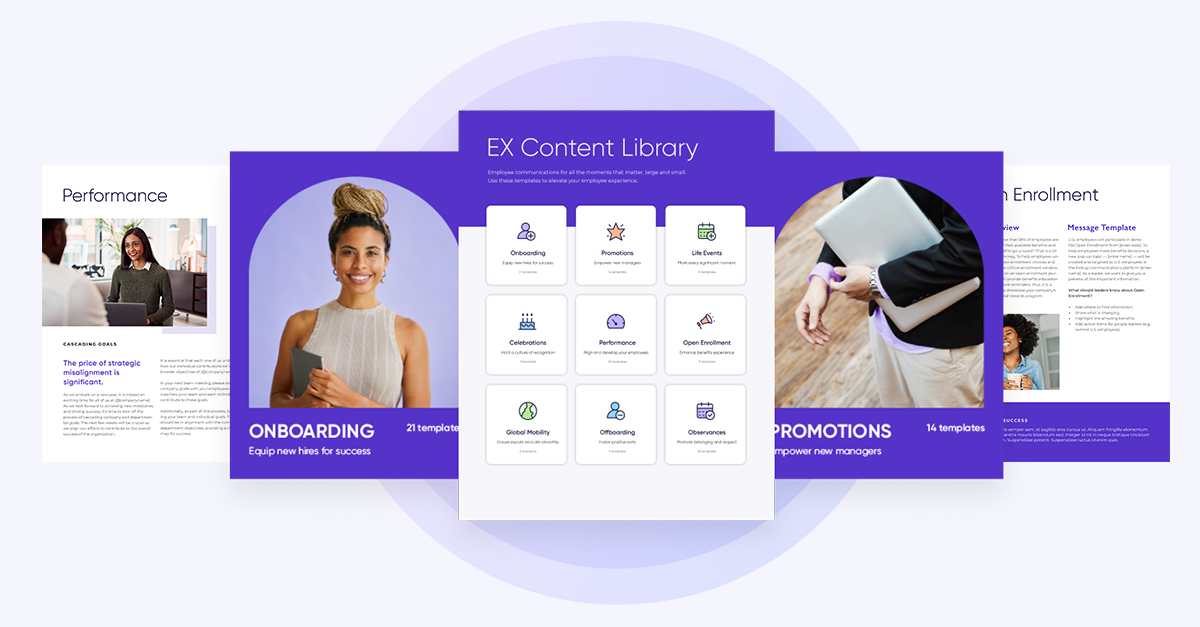When the employee experience isn’t taken into account, most digital workplace initiatives fail.
At Gartner Workplace Summit, we learned firsthand why the C-suite has made the digital workplace a high priority and how organizations that invest in the employee experience could improve employee engagement scores (by up to 10 percentage points).
Not surprisingly, one of the primary takeaways from the summit was that everyone needs to take ownership of digital workplace initiatives if you want them to succeed. “Digital workplace initiatives cannot be treated exclusively as an IT initiative,” said Carol Rozwell, distinguished research vice president at Gartner. “When initiatives are executed as a series of technology rollouts, employee engagement and addressing the associated cultural change are left behind. Digital workplace success is impossible without such [collaboration].”
What is the digital workplace?
The digital workplace is aligning technology (existing and new) and business processes around strategy.
Today, companies can’t become digital businesses without a digital workplace. It is a C-suite priority, and leaders must reassess how their greatest asset (their employees) work and collaborate.
Why now with the digital workplace?
At the Gartner summit, we heard many reasons leaders are making the digital workplace a high priority. These include:
- Teams and technology are siloed across the company,
- Organizations are not thinking of technology solutions holistically,
- Comms leaders need more personalization to retain and attract talent,
- Companies are still using old technology,
- Frontline workers are being completely left out of the picture, and
- IT can be more agile when it has the most up-to-date technology.
How to develop a culture of digital dexterity by leveraging technology
Leveraging technology in today’s fast-paced business world depends on the ability of your employees to collaborate, communicate, and innovate. Leaders must ask employees to rethink the way they engage with their workers, and help workers engage with one another.
Redesigning the workplace is about changing your approach to technology, social networks, and leadership practices. It also means ensuring a great employee experience.
According to an MIT study, the dynamic between the technology and the way people work is most tangible when it comes to measuring success. Organizations focused on enhancing the digital workplace see significant improvements in performance when measured against the performance of their competitors.
Embracing the digital workplace revolution
The emerging digital workplace will answer a variety of problems that will spin the wheel and help business drivers—including increased revenue, reduced operating costs, greater innovation, increased productivity, higher flexibility, stronger talent, and improved employee experience—come to life.
It will offer the necessary support when it comes to shifts in working styles that allow for employees to function more transparently and more efficiently leverage social networks.
Digital workplaces will also unify internal communications by enabling employees to stay connected through the channels of their choice (including mobile). This allows for the employee experience to exist outside the typical company firewall. When used correctly, digital workplaces can provide flexibility and personalization. That’s because digital workplaces allow for the integration of different apps and software, which facilitates easier workflows for employees.
Virtual work environments allow employees to remain connected in different offices across the world while still maintaining a balance between customer privacy and operational risk. This, in turn, minimizes spending and allows for a better employee experience through enhancing productivity, because employees are equipped with the right tools and information at the right time.
Companies using digital workplaces are able to win the war on talent by showcasing their progressive and unique working environment, where top candidates are learning to expect from employers.
A more humanized workplace
The end goal of a digital workplace enhanced by technology should be to achieve a workplace that is more (not less) human. Globalization, technology, and increased expectations are making leaders ask how they can learn and adapt quickly while achieving a more human workplace.
Principles such as Purpose over Profit, Freedom over Control, Open over Closed, Progress over Perfection and Consent over Consensus, can help the companies put in place a digital workplace which will enable workers to do the best work of their lives. The idea is to ask the workers a simple question: “What is stopping you from doing the best work of your life?” and start implementing policies based on the answers.
Digital workplace as the go-to for employee happiness
Managers are increasingly aware of how much the digital workplace can be used as a lever for achieving employee happiness. A Harvard Business Review study showed that 87% of senior managers find achieving effective digital workplaces to now be a priority, with the majority saying it is a do-or-die imperative.
Currently, 62% of senior managers are actively implementing management initiatives and transformation programs in order to make their business more digital, which will, in turn, satisfy their employees.
Five pillars of digital workplace success
The human capital changes as a result of the digital workplace can be sorted into five key pillars that lead to digital workplace success.
1. Digital workplaces are the workplaces of the future.
Technology is changing almost everything about how we work, which is what we heard many times at the Gartner Workplace Summit. The C-suite sees the digital workplace as a top priority and now leaders are taking steps to make it happen.
2. Digital workplaces require a great communications strategy.
Companies are trying to design an irresistible experience for their employees. This would allow them to engage employees and get them working harmoniously toward the organization’s mission and objectives.
This is where a strong communications strategy paired with a workforce communications platform comes in. Because if employees are not kept in the loop, business initiatives may fail. Also, CIOs must understand that they must take accountability for shaping the company culture, not just CHROs.
3. Digital workplace success must be holistic.
The changes leaders make can have a big impact on all employees. That includes remote workers, contract employees, frontline employees, and employees who come into the main office every day. The technology you choose must serve all groups. It’s not about buying more tools that only solve one problem for one team. IT needs to look at the technology and challenges holistically.
4 Digital workplaces must integrate existing tools.
Take advantage of your existing tools. A digital workplace transformation doesn’t necessarily mean a complete replacement of your existing technology. Integrate new tools with whatever is currently working for your teams. This allows for workers to operate in very different ways and leverage different digital technologies to improve efficiency.
Additionally, IT must look for tools that not only integrate other software but create a platform to unify the technology. For example, a workforce communications platform (or employee engagement platform integrates all your communications channels giving you one place to create, target, schedule, and publish communications to the channels your employees prefer).
5. Digital workplaces sustain organizational performance.
This involves constant reevaluation of how you use your workforce and employees to improve performance in the organization that does not rest. This will, in turn, keep on driving more and more impact on the bottom line of the workforce.
Recap: How the digital workplace can improve the employee experience
We attended the Gartner Workplace Summit 2019 to get a better understanding of the state of the digital workplace. Here’s what we learned:
- The digital workplace is a high priority for the C-suite
- IT needs to think of tech solutions more holistically
- Frontline workers are finally getting the attention they deserve
- The employee experience can be improved with the digital workplace
- Internal communications is a critical component
- If we don’t embrace the technology, we may be left behind








